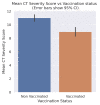Comparison of Imaging Severity Between Vaccinated and Unvaccinated COVID-19 Patients: Perspective of an Indian District
- PMID: 36407251
- PMCID: PMC9671272
- DOI: 10.7759/cureus.30724
Comparison of Imaging Severity Between Vaccinated and Unvaccinated COVID-19 Patients: Perspective of an Indian District
Abstract
Background: Extensive vaccination drives undertaken globally helped in the fight against the coronavirus disease 2019 (COVID-19) pandemic, but different nations adopted different vaccination policies to tackle the disease. The vaccination drive in India began with the administration of two different vaccines: Covishield and Covaxin. We assessed the effect of vaccination status on imaging severity in patients with positive COVID-19 reverse transcription-polymerase chain reaction (RT-PCR)/antigen tests.
Method: This was a single-center retrospective observation analysis carried out over three months between March 1, 2021, to May 31, 2021. Data access was provided by the District Hospital Review Board (DHRB) and the Department of Health (DOH), District Ambala, Haryana. Appropriate statistical tools were used to analyze the data. Statistical Package for Social Sciences (SPSS) 26.0 and Python 3.9 were used for statistical analysis and visualization, and a p-value of less than 0.05 was considered statistically significant.
Results: The total sample size of the study was 1,316, out of which 371 (28.2%) were vaccinated and 945 (71.8%) were not vaccinated. The mean age of the study participants was 49.6 ± 15.7 years. Seven hundred ninety-seven (60.6%) participants were male, while 519 (39.4%) participants were female. A statistically significant reduction was observed in the computed tomography severity score (CTSS) of the vaccinated population compared to the non-vaccinated group (χ2 = 74.3, p < 0.001). Vaccination led to a statistically significant decrease in mean CTSS across all lung lobes.
Conclusion: Emerging COVID-19 variants challenge the effect of available vaccines, with different nations adopting different vaccination strategies to deal with the ongoing health problem. CTSS was employed as an objective marker to study the disease severity and effect of vaccination. Vaccination resulted in a significant reduction in CTSS seen on high-resolution computed tomography (HRCT) chest scans. There was a significant decrease in the incidence of severe COVID-19 pneumonia among vaccinated individuals. We need more observational data to corroborate the efficacy of vaccines presented in the randomized trials. Sharing such data between different nations can help us adopt a unifying vaccination strategy and decrease the impact of COVID-19 in subsequent disease waves.
Keywords: computed tomography severity score (ctss) of chest; covid-19; covid-19 vaccine; hrct chest (high resolution computed tomography); severe covid-19.
Copyright © 2022, Singhal et al.
Conflict of interest statement
The authors have declared that no competing interests exist.
Figures



References
-
- CO-RADS versus CT-SS scores in predicting severe COVID-19 patients: retrospective comparative study. Zayed NE, Bessar MA, Lutfy S. Egypt J Bronchol. 2021;15:13.
LinkOut - more resources
Full Text Sources
Miscellaneous
